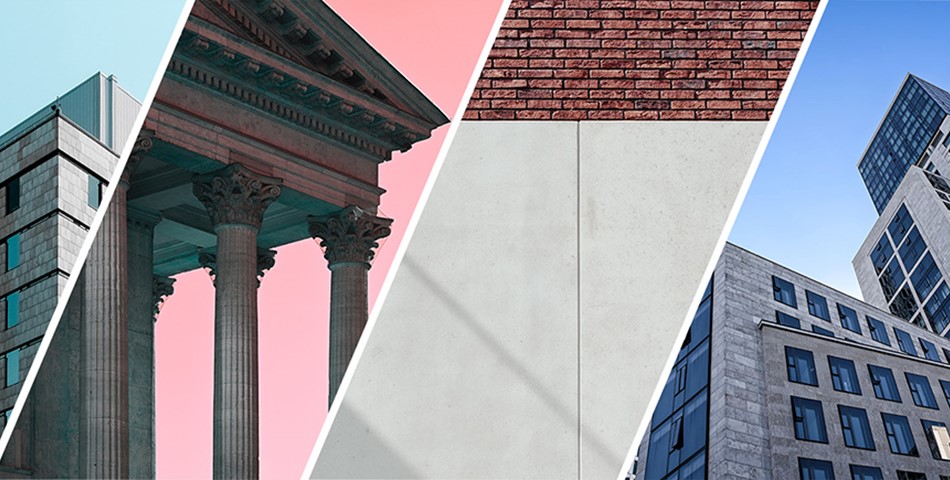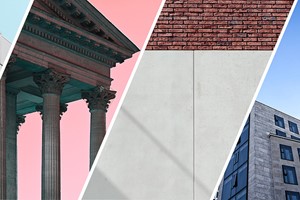Stone building facades add masses of aesthetic appeal to an otherwise normal-looking building. But aesthetics is just one benefit among a list of functional improvements that stone facades and cladding can offer, such as protecting a building from the elements and improving its resistance to temperate (both hot and cold).
With so many different types of stone available, the skyline of cities across the world is often dominated by wonderful, unique stone designs. The challenge for many building owners comes down to one of choice: Natural stone or artificial? Marble or granite? Cheap to buy or cheap to maintain?
Let’s start with the foundations: natural stone and artificial stone.
Traditional stone facades were mainly made using natural stone
Natural stone is an architectural material that offers a number of benefits to the building, including durability and a rich appearance. It can be found in many forms and colors, which makes it suitable for a variety of purposes.
When used in the construction of building facades, natural stone can reduce the amount of energy used in buildings as well as provide a more attractive appearance. Besides protecting the building from the elements, natural stone doesn’t fade as easily in direct sunlight and has even been known to reduce the rate at which a building absorbs heat during high temperatures.
The type of natural stone building owners choose will depend on their budget, the style of their commercial building, and what they have available from their local building or cladding supplier. Below are some of the most commonly found natural stones in building facades and cladding.
Marble
Marble stone cladding is a natural stone that comes in many shapes, sizes, and varieties. It is neither stain-proof nor does its durability justify its pricing. But the stone’s color and texture are what make it a popular choice for hotels, offices, and other commercial properties even though it is more expensive than other options.
Granite
Granite is another popular choice for natural stone cladding due to its durability and beauty. It is known for having excellent heat resistance which makes it ideal for use in high-rise buildings where there may be concerns about fire safety.
Limestone
Limestone is the most versatile of all stones because it takes on a variety of finishes and can be worked in many ways. It can be stained to create a creative assortment of patterns, painted or sealed to protect against moisture, stained again for a more natural look, and even carved into intricate designs.
No wonder limestone has been used for centuries in architecture with historical significance worldwide (such as the Egyptian pyramids), with no signs of decline in popularity.
Sandstone
Sandstone is a popular choice for exterior applications, particularly if building owners are looking for a natural stone façade appearance. Sandstone is also perceived as having more character than other types of stone, which makes it perfect for an otherwise monotonous theme or building lacking charisma. Even with the grains in sandstone being very small, a building façade made of sandstone is less likely to crack or chip than other types of stone, making it highly durable.
Slate
Slate is known for its natural aesthetic appeal and is an ideal material for properties in unpredictable weather because of its excellent resistance to water damage and mildew. It also holds up well against wear and tear, is fireproof, and can withstand extreme heat without cracking or breaking down. Slate cladding is also considered to be one of the most effective construction tools in terms of insulation.
Modern stone facades are a combination of both natural and artificial stone
Artificial stone facades are a good alternative to natural stone facades. They offer the same durability and strength as natural stone (sometimes, better), but at a fraction of the cost. Most notably, artificial stone is known for its controlled quality. This means that property owners can predict how the stones will perform once installed, which is one of the biggest reasons for their popularity. The most common types of artificial stone cladding are:
Concrete paneling
Concrete panels are made from recycled concrete that has been bonded together with mortar. They come in many different styles and colors and can be installed on almost any surface. The panels are usually attached to wall framework and secured with ties, anchors or adhesives.
Brick veneer
Brick veneer is made from blocks of masonry or concrete that have been covered with thin layers of stucco (a construction material made of aggregates, a binder, and water). This type of cladding is used on both interior and exterior walls, depending on the budget and project requirements, but it finds its place in modern stone facades quite often.
Artificial marble
Artificial marble is formed by pouring liquid concrete into moulds that are used to cast it. It is manufactured in a way so as to give it a similar appearance to natural marble. This type of marble is almost indistinguishable from natural marble in terms of its appearance, texture and coloration, which is why it is popularly used by architects and builders to provide the illusion of natural stone in their projects.
There are several benefits to using artificial stone cladding over natural stone, including:
Natural appearance: While natural stone is beautiful, it can be difficult to maintain. Artificial stone can be painted or stained in any color, making it more attractive and easier to maintain than natural stone surfaces.
Easy maintenance: Many types of artificial stone are fairly easy to care for and maintain, making them a great choice for property owners who want to avoid the messy job of painting or staining natural stone surfaces to increase their life.
Cost: The cost of artificial stone cladding is significantly lower than natural stone. This makes it an attractive option for property owners who want their properties to look sleek or contemporary without having to break the bank. The cost savings are especially evident when it comes to exterior applications where there are lower maintenance costs involved, unlike with natural stone.
Durability: Artificial stone cladding is proven to be extremely durable over time in many applications due to its synthetic nature and superior construction methods used during production. It has the ability to withstand weathering exceptionally well, as well as providing remarkable resistance to fires, natural disasters, insects and mould.
Cladding cleaning and restoration services
Stone facades may be more expensive than other types of exterior finish, but it’s an investment worth making when you consider the durability and beauty of stone — both aesthetically pleasing as well as functional.
Regardless of whether your building’s skin is made from natural stone, artificial stone, glass or even metal, restorative cleaning is an essential part of keeping it maintained and properly functioning.
At See Brilliance, we help commercial building owners restore and maintain all types of building facade so that they can retain their pristine exterior for years to come. Our techniques, products and systems are laboratory tested and approved by façade producers, RIBA and Historic England.











